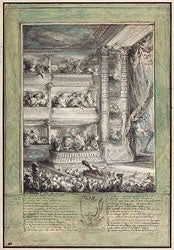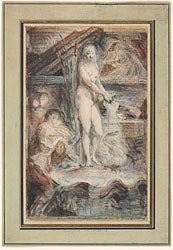Gabriel de Saint-Aubin (1724–1780)
October 30, 2007, through January 27, 2008
| |
 |
|
|
| |
Saint-Aubin, Voltaire’s “Coronation” at the Théatre Français on March 30, 1778, 1778, watercolor over pen and black ink and brush and gray wash, Musée du Louvre, Paris |
|
|
Saint-Aubin’s fascination with the Parisian stage and his admiration for the writings of Voltaire merged most wonderfully in two of his greatest late works. One shows the famous author shortly before his death, making one of his final public appearances (right). On the evening of March 30, 1778, Voltaire received two spontaneous ovations at the Théâtre Français during the sixth performance of his tragedy Irène: first, when he entered his box and was crowned with a laurel wreath by the actor Brizard and the marquise de Villette; and, again, immediately after the play, when the entire company took turns crowning his portrait bust on stage. Instead of choosing between Voltaire’s coronation at the beginning of the evening and the figurative coronation of his bust a few hours later, Saint-Aubin asked viewers to imagine both as part of a single glorious moment.
| |
 |
|
|
| |
Saint-Aubin, Allegory in Honor of the Death of Voltaire, c. 1779, black chalk, pen and brown ink, brush and gray wash, and watercolor, Rijksmuseum, Amsterdam |
|
|
Close to the time of his own death, Saint-Aubin produced a stranger and more idiosyncratic tribute to his literary hero (left). In a drawing bursting with images and annotations, he creates a dreamlike mélange of unlikely juxtapositions. The central figure of a lovely but mournful naiad, based on a sculpture by Houdon, pours water from an urn into a shell-shaped vessel. The spray agitates a swan (an attribute of Poetry) near her feet, while a muse opposite tranquilly inscribes a scroll with the words: “His spirit is everywhere, but his heart is here alone” (a reference to the author’s beloved residence, the Château de Ferney). Above is Voltaire’s tomb. As the philosopher lifts himself up in his coffin to continue writing, inevitable Death places a seal upon his lips.
Identifiable art objects by contemporary masters play a vital role in Saint-Aubin’s composite drawings, combining complex and disparate elements in a way that is unique to him. In what is probably the single most beautiful extant example (below right), he depicts a portrait of the famous actress Mademoiselle Clairon (in the upper right area), not taken from life but selectively copied from an engraving. However, the true star of this image is a magnificent clock with astronomical mechanisms, which was offered for sale in Paris in 1773, the year this drawing was made. As in his Salon views, the work of other artists is filtered through Saint-Aubin’s subtle perceptions.
| |
 |
|
|
| |
Saint-Aubin, Sheet of Studies: Castel’s Clock, Various Portraits, and Carved Group, 1773, black chalk, bister, and brush and gray, yellow, and pink washes, Musée du Louvre, Paris |
|
|
The key to Saint-Aubin’s originality may be his refusal to accept preconceived boundaries for the interpretation of any given subject. Saint-Aubin confidently recombined traditional elements to meet his own finely tuned thematic purposes. He prized the small details of everyday experience that dwell in our memories of life’s greatest occasions. And like the history painter he fully deserved to be called, he aspired to the ephemeral essence of events otherwise soon to be absorbed into the historic past. He surpassed all of his contemporaries in his awareness of how everyday events are perceived by the mind and the eye, not as accumulated pieces of information but as living moments captured in time. Through the matchless power of his pictorial imagination, Saint-Aubin discovered a new and intensely personal way of portraying the city that was his world.
— Kim de Beaumont, Guest Curator
Return to First Page >>> 1 2 3 4
The accompanying catalogue is available, in both English and French, in the Museum Shop and on our Web site, at www.shopfrick.org.
Gabriel de Saint-Aubin (1724–1780) was organized for The Frick Collection by Colin B. Bailey, Peter Jay Sharp Chief Curator, and Kim de Beaumont, Guest Curator; the curators at the Musée du Louvre are Pierre Rosenberg, President-Director Emeritus, and Christophe Leribault, Chief Curator in the Department of Drawings.
Major funding for Gabriel de Saint-Aubin (1724–1780) has been provided by The Florence Gould Foundation. Additional generous support has been provided by The Christian Humann Foundation, the Michel David-Weill Foundation, and The Grand Marnier Foundation.
 |
|
The project is also supported, in part, by an award from the National Endowment for the Arts. |
|


